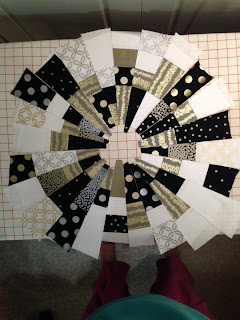I am part of a small group from the
Houston Modern Quilt Guild that is reading Carolyn Friedlander's book,
Savor Each Stitch: Studio Quilting with Mindful Design.
We have completed the chapter on "line", and are currently working on
projects for "contrast". The chapter is mostly about contrast in value. To play with that, I decided to "go gray" and really focus just on the effect of different values and eliminate the effect of color -- like yellow next to medium purple, which represents both contrasts in value and color -- although I could not resist throwing in one little spark of color.
Years ago I took a class with
Caryl Bryer-Fallert (now Gentry) on appli-piecing, and I bought a bunch of fat eighth packets in her hand dyed gradations. Important for this, I still have (had) a 7 step gray gradation, to which I added white (actually, I thought it was what, but turned out to be a light woven fusible interfacing -- I fused two layers to each other and used it anyway), and black (probably Kona black).
 |
| Seven step gradation plus white and black and magenta |
I used EQ7 to adapt a circular design in the book and to plan the coloration (valuation). I also carefully tested whether the planned size templates would fit my fat eighths, since there is no getting more of this fabric.
The values change in a grid of columns and rows (see completed quilt below). In each column, the background (A) and thin crescent (B) are the same value, and in each row uses a different pair of values, with the fat crescent (C) using one gray and the bottom quarter circle (D) using a different darker gray. The shades progress left to right and top to bottom, from light to dark. I cannot get over how different the same value looks depending on what it is next to.
 |
 |
| Original EQ7 mock-up |
One version of the block (6"x6" finished) |
There are 2 'isoforms' of the block, so I printed all the templates on
freezer paper and then carefully labeled the colors and versions before
cutting apart and ironing onto the fabrics. As you can see, I used nearly every bit. After cutting out each piece, both C seam allowances and the concave B allowance were clipped and then, using a washable glue-stick, turned under and glued to the paper side of the freezer paper. Using a lightbox, the pieces were aligned on the seam line and glued in place with more glue stick or a thin line of Roxanne Glue-Baste-It. This process results in a very flat, stable and perfectly aligned block that is ready for either hand (not me) or machine applique. I used a very narrow zigzag with a very thin (Invisifil) thread. Once the seams are stitched, the freezer paper comes out easily and all the glue rinses out.
 |
 |
| Freezer paper templates marked & ironed in place |
Free cutting the pieces | |
 |
| Row 1, Column 2 and 3 blocks assembled and sewn together |
 |
| Quilt top |
I've layered things up for quilting using a silk batting that I've been wanting to try, and a dark gray oriental print on the back that is left-over from a previous project. I decided to limit the contrast in thread color and focus on texture, so I bought (this is supposed to be 'use what you have', but Anna V in the book says "thread doesn't count" and that's good enough for me) 4 shades of gray Kimono silk and plan to match by row and column.
 |
 |
| Silk threads |
Sketches to try out different quilting designs |
 |
| Partially completed quilting |
Things are really coming together although it has been hard to find time to work on this. AND, the jury is still out on binding -- binding or facing? if binding, what color? I'll cross that bridge when I come to it. I find that things often look different when they are sewn up or quilted, so I try not to decide more than I have to, until I have to (I think that is an old software design principle).
Hopefully, it will be done in time for the next book group meeting.
Until then I'm linking up with
Lee at Freshly Pieced for Wednesday WIPs ...
Update: ....................................
I finished all the quilting and after considering the binding/facing options decided to go with this hand dyed green binding -- a fat quater I got from Frieda Anderson.
 |
| Close up of the upper corner. |
 |
| Value Does the Work (front) |
 |
| Value Does the Work (back) |
I used the remaining bits from the piecing to improvisationally piece a square for the back. The backing fabric is pieced down the center, along the left edge of the square. The pieced square was 'set-in' to the backing fabric (no pieced seams) on the right half. You can see that I used black or gray bobbin thread, depending on the thread and fabric color on the front.
The final thing I need to do is embroider the shade numbers in the binding.
 |
| Roadmap showing which shade was used where. |
This was a wonderful experiment and I love how it turned out. It is also a nice allegory for how much we need the parts that don't get much credit. I plan to find a place of it in my office.
Susan
PS I completely missed it, but this quilt was featured as quilt of the day for June 16, 2015 on
The Quilt Show.
PPS I'm delighted to report that this quilt was accepted into QuiltCon 2016.




















































